“X-FACTOR DAC” Digital-to-Analog Converter
Russian-made products very rarely arrive to our offices, especially of such a high class. The general concept of this digital-to-analog-convertor, its building quality and its physical weight and dimensions really blow your mind. Just consider that its external power supply alone contains 18 transformers and weighs all 60 kilograms!
We will audition this Russian novelty in our reference system of top-notch components installed in an acoustically treated room.
We will audition this Russian novelty in our reference system of top-notch components installed in an acoustically treated room.
by Nikolay Yefremov
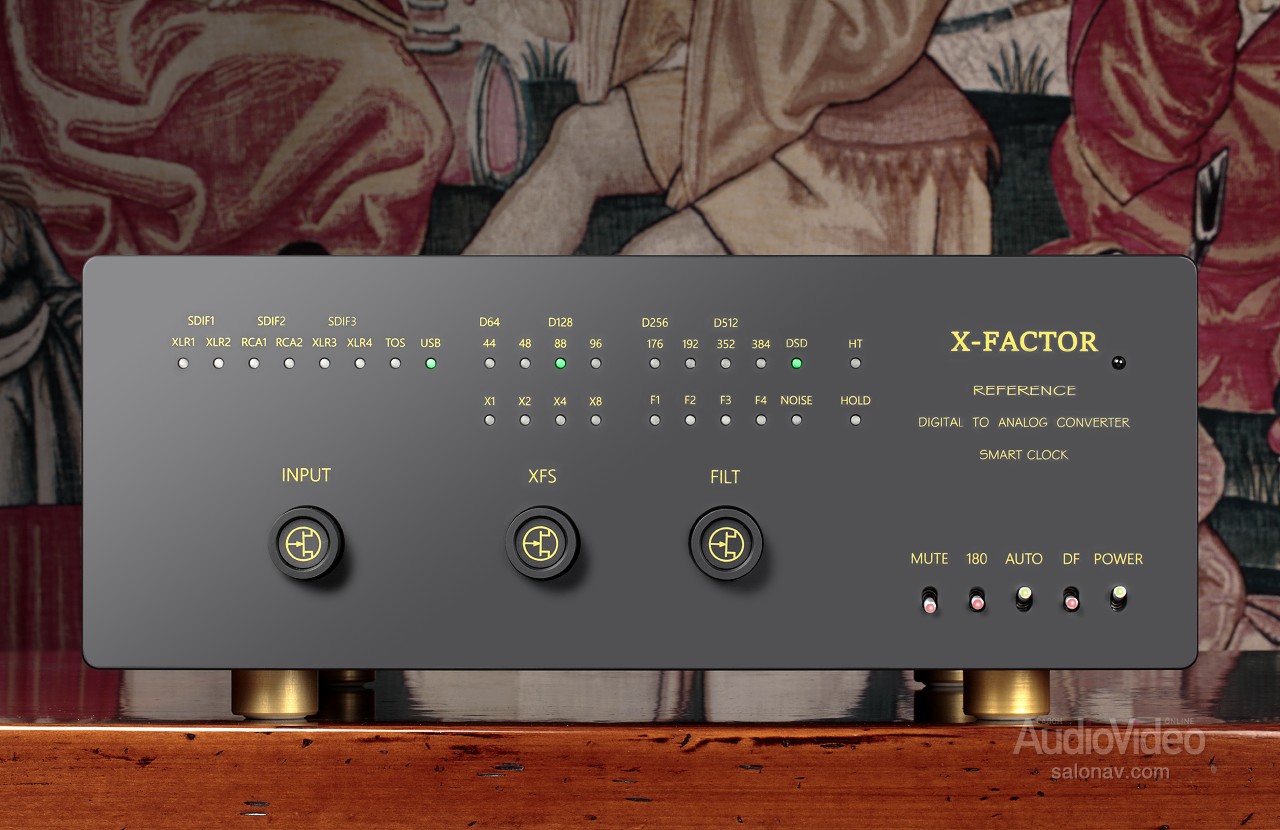
Confronting The Unknown
All attempts to produce the best ever audio component quite often end up in failure – as you do need at your disposal not only the highest possible qualification, but also a lot of energy and a huge material resource. Although, there are exceptions from every rule, and one of them is right in front of us. This is pre-production sample of X-Factor DAC, a product by the eponymous Russian company, in which its developers’ most significant ideas collected through the years are densely packed. And the ideas, I must add, are implemented here without any compromises.
Let’s consider the external power supply. It’s assembled in a separate chassis which does weigh all 60 kgs. There are 18 transformers in it, each one of them outputs two different voltages and designed according to their nominal magnetic fluxes of 0.6 T and 0.7 T. Their humongous size and even that fact that they operate in a low intensity mode notwithstanding, each of them is encased in a steel shield with a thickness of 2 mm. The power supply’s total available power is 700VA. Its rectifier is built around ELNA Cerafine capacitors, with the total capacitance of one Farad, and 36 voltage pre-regulators. When the power supply is turned on, a set of relays would feed voltage to the transformers in a certain sequence, and at turning it off a reverse sequence is taking place.
There are two DACs with different architecture – multi-bit PCM1704 and delta-sigma AK4497 - in the main DAC unit (which, as a rule, employs just one type of conversion). The first chip is considered one of the best sounding, although it doesn’t support DSD. Moreover, even if AK4497 is a two-channel chip, there are two of those in X-Factor DAC – as only half of each chip is engaged for either the Left or the Right channel. The amount of cross-channel noise is significantly diminished in such an implementation, and as a result of this, both the overall signal-to-noise ratio and the conversion precision are substantially improved.
All attempts to produce the best ever audio component quite often end up in failure – as you do need at your disposal not only the highest possible qualification, but also a lot of energy and a huge material resource. Although, there are exceptions from every rule, and one of them is right in front of us. This is pre-production sample of X-Factor DAC, a product by the eponymous Russian company, in which its developers’ most significant ideas collected through the years are densely packed. And the ideas, I must add, are implemented here without any compromises.
Let’s consider the external power supply. It’s assembled in a separate chassis which does weigh all 60 kgs. There are 18 transformers in it, each one of them outputs two different voltages and designed according to their nominal magnetic fluxes of 0.6 T and 0.7 T. Their humongous size and even that fact that they operate in a low intensity mode notwithstanding, each of them is encased in a steel shield with a thickness of 2 mm. The power supply’s total available power is 700VA. Its rectifier is built around ELNA Cerafine capacitors, with the total capacitance of one Farad, and 36 voltage pre-regulators. When the power supply is turned on, a set of relays would feed voltage to the transformers in a certain sequence, and at turning it off a reverse sequence is taking place.
There are two DACs with different architecture – multi-bit PCM1704 and delta-sigma AK4497 - in the main DAC unit (which, as a rule, employs just one type of conversion). The first chip is considered one of the best sounding, although it doesn’t support DSD. Moreover, even if AK4497 is a two-channel chip, there are two of those in X-Factor DAC – as only half of each chip is engaged for either the Left or the Right channel. The amount of cross-channel noise is significantly diminished in such an implementation, and as a result of this, both the overall signal-to-noise ratio and the conversion precision are substantially improved.
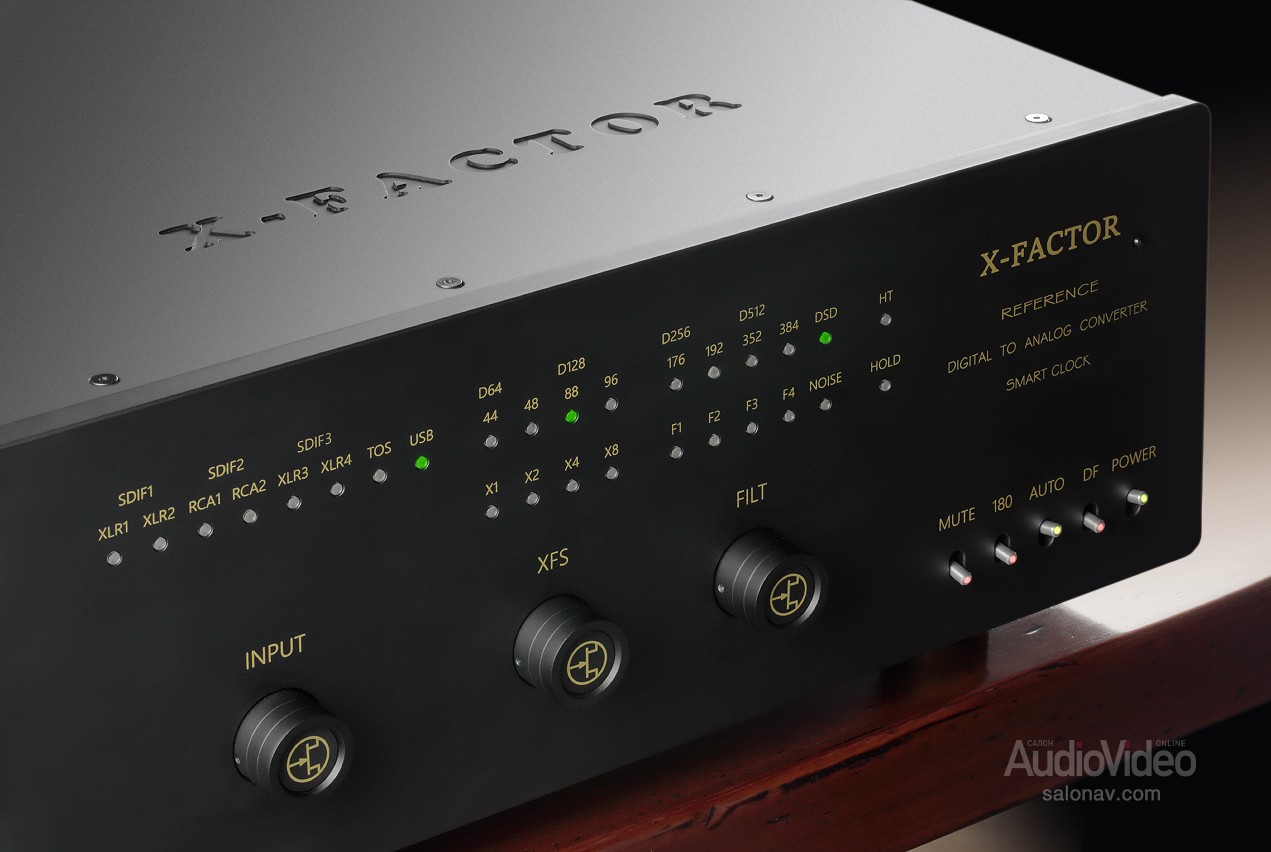
As you can switch the DAC’s operation between the PCM and AKM chips on the fly via the supplied remote control, this provides a listener with a great opportunity to formulate his or her own preferences regarding which technology is the best sonically – either multi-bit or delta-sigma. Besides, there is an automatic mode in the DAC, when the chips switch over automatically, depending on the incoming signal’s parameters.
AK4497’s pre-installed digital filters are not used in the DAC, as they are not applicable with the DSD signal, and also because the X-Factor designers don’t see them as appropriate for the DAC’s general concept. The proprietary digital filters here are implemented on SHARC 21489 Second Generation DSP chip. This chip is used in the mode of eight 40-bits floating point calculations per each of 400 MHz cycles, which means that it processes data here with a rate of 3 200 million of data operations per second. The DSP chip’s power and memory storage capacity specifications allow for six-channel operation, although in this case only two are used.
There are four proprietary digital filters available in the stock version of the X-Factor DAC. The first one is a standard one, with a steep roll-off at 160dB per octave. The second one – to be used with the highest sampling rates - has the widest bandwidth. The third one imitates a typical frequency response of a transformer-coupled tube power amplifier, that is, it provides a first-order gradual roll-off after 30 kHz. The fourth one, which is called “retro”, provides a similar roll-off after 15kHz. Actually, the latter filter happened to be our reviewing team’s favorite one during preliminary auditioning sessions. It could be that due to the fact that quite a few of CDs are mastered at 0dB peak level, then when such a recording clips, this filter removes the sporadic high frequency noise and, as a result of it, reconstructs the signal’s original waveform. Moreover, on old recordings, such as 40-ies and 50-ies jazz ones, the bandwidth is limited on top at 13-14kHz, therefore in a wide bandwidth system the rest of the bandwidth, under such a scenario, will be filled with nothing but noise.
AK4497’s pre-installed digital filters are not used in the DAC, as they are not applicable with the DSD signal, and also because the X-Factor designers don’t see them as appropriate for the DAC’s general concept. The proprietary digital filters here are implemented on SHARC 21489 Second Generation DSP chip. This chip is used in the mode of eight 40-bits floating point calculations per each of 400 MHz cycles, which means that it processes data here with a rate of 3 200 million of data operations per second. The DSP chip’s power and memory storage capacity specifications allow for six-channel operation, although in this case only two are used.
There are four proprietary digital filters available in the stock version of the X-Factor DAC. The first one is a standard one, with a steep roll-off at 160dB per octave. The second one – to be used with the highest sampling rates - has the widest bandwidth. The third one imitates a typical frequency response of a transformer-coupled tube power amplifier, that is, it provides a first-order gradual roll-off after 30 kHz. The fourth one, which is called “retro”, provides a similar roll-off after 15kHz. Actually, the latter filter happened to be our reviewing team’s favorite one during preliminary auditioning sessions. It could be that due to the fact that quite a few of CDs are mastered at 0dB peak level, then when such a recording clips, this filter removes the sporadic high frequency noise and, as a result of it, reconstructs the signal’s original waveform. Moreover, on old recordings, such as 40-ies and 50-ies jazz ones, the bandwidth is limited on top at 13-14kHz, therefore in a wide bandwidth system the rest of the bandwidth, under such a scenario, will be filled with nothing but noise.

All filters were designed here to allow the DAC to ideally reproduce the step signal, that is, to avoid any frequency response distortions while reproducing the complete sound spectrum. Also, there is a provision to turn the digital filter off. Beside the suite of several digital filters (and digital filter off mode), the DSP chip is used as a buffer for the incoming data stream (with a capacity of 8 000 samples) to decrease the amount of jitter in the conversion process.
X-Factor DAC provides an opportunity to change the over-sampling rate of the incoming signal (1x, 2x, 4x, 8x) via pushing buttons either on its remote control or on its faceplate. This is also an interesting field for experimentation, as it’s possible now to select an optimal oversampling rate for each recording by just listening to it while switching over between all the available rates.
The clock used in the DAC is made by NDK, it’s thermo-stabilized within +/- 0.5 degrees Celsius, and its jitter performance indicated as no greater than 43 femto-seconds. The DAC has two outputs to clock external devices. The DAC recognizes a digital signal’s input parameters and automatically select an optimal – for this particular signal - clock generator’s frequency (the faceplate signage “Smart Clock” refers to this feature).
XMOS USB module and the drivers’ software used in the DAC is sourced from JL Sound and it’s got a built-in galvanical isolation. This module’s advantages include I2S output and up to native DSD512 and PCM32/768 capabilities. It’s also capable of DSD1024 operation but the manufacturer does not supply the appropriate software yet. But it’s totally future-proof, so when the software will become available it can be easily loaded to the existing hardware.
There are two SPDIF receivers here, moreover, they can operate either in the standard mode at 192 kHz, or in the SDIF mode which allows to receive the signals up to 384 kHz via splitting the overall signal to two – the left channel signal and the right channel one. The latter mode is necessary when the DAC should be connected to some professional digital source equipment, such as made by DCS, Weiss, Aurender, etc.
X-Factor DAC provides an opportunity to change the over-sampling rate of the incoming signal (1x, 2x, 4x, 8x) via pushing buttons either on its remote control or on its faceplate. This is also an interesting field for experimentation, as it’s possible now to select an optimal oversampling rate for each recording by just listening to it while switching over between all the available rates.
The clock used in the DAC is made by NDK, it’s thermo-stabilized within +/- 0.5 degrees Celsius, and its jitter performance indicated as no greater than 43 femto-seconds. The DAC has two outputs to clock external devices. The DAC recognizes a digital signal’s input parameters and automatically select an optimal – for this particular signal - clock generator’s frequency (the faceplate signage “Smart Clock” refers to this feature).
XMOS USB module and the drivers’ software used in the DAC is sourced from JL Sound and it’s got a built-in galvanical isolation. This module’s advantages include I2S output and up to native DSD512 and PCM32/768 capabilities. It’s also capable of DSD1024 operation but the manufacturer does not supply the appropriate software yet. But it’s totally future-proof, so when the software will become available it can be easily loaded to the existing hardware.
There are two SPDIF receivers here, moreover, they can operate either in the standard mode at 192 kHz, or in the SDIF mode which allows to receive the signals up to 384 kHz via splitting the overall signal to two – the left channel signal and the right channel one. The latter mode is necessary when the DAC should be connected to some professional digital source equipment, such as made by DCS, Weiss, Aurender, etc.
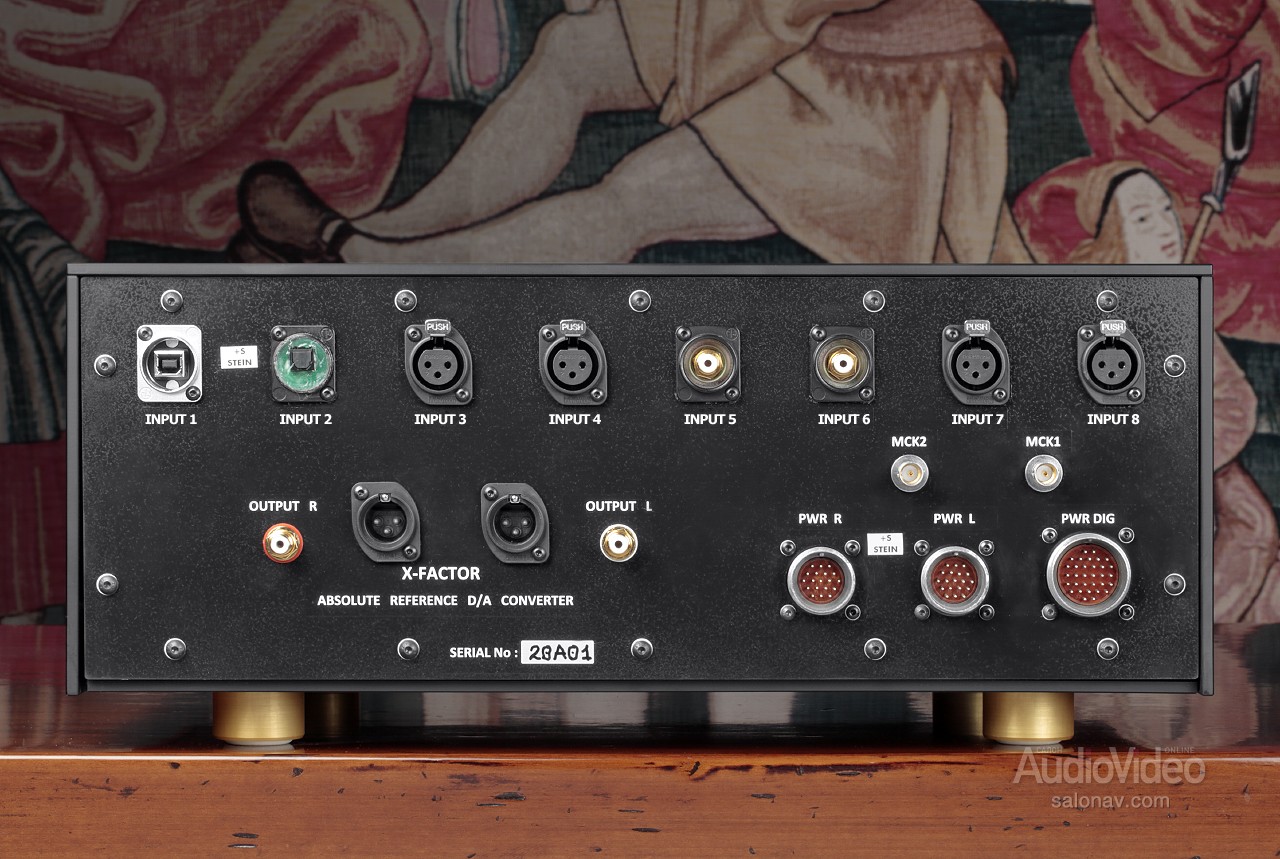
The DAC’s analog part topology is single-ended – from the DAC chips all the way to the X-Factor’s output connectors (including the XLR ones, in which just one pin carries the signal). The DAC’s designers believe that, in terms of absolute sound quality, only transformer coupling can provide appropriate balanced output, however, to get the full bandwidth starting at 0 Hz (any compromise on this issue they don’t even want to discuss) the transformers should be humongous. At the moment, the engineers are working on a possibility to provide a DAC’s external balanced output option based on such transformers.
The analog buffer of the X-Factor, including its current-to-voltage converter just after the PCM 1704 IC chip, is assembled only using discrete parts and operates in a “deep” class A. Its output stages are built with powerful microwave J-FET transistors operating at idle current of 300mA. To fight the detrimental influence of the skin-effect on the signal and to decrease the noise coming from the digital boards, the analog output boards are 8-layer boards with interconnected parallel conducting surfaces, as the whole bandwidth of the analog part of the DAC is limited to only from 0 to 50 MHz, while the digital signals’ frequency can be in the GHz region. The single-ended topology was chosen because its typical harmonics spectrum is very pleasing to ear – a la some venerable examples of single ended tube amplifiers.
The DAC has a modular design, the modules are interconnected via a two-layer cross-board. This provides a lot of flexibility for future upgrades – if a new chip arrives, the old module can be easily replaced with a new one. The DSP board is also a separate one, it’s installed via a DIP-panel, which substantially simplify any new DSP chip replacement and also, if necessary, an installation of custom digital filter downloads.
The analog buffer of the X-Factor, including its current-to-voltage converter just after the PCM 1704 IC chip, is assembled only using discrete parts and operates in a “deep” class A. Its output stages are built with powerful microwave J-FET transistors operating at idle current of 300mA. To fight the detrimental influence of the skin-effect on the signal and to decrease the noise coming from the digital boards, the analog output boards are 8-layer boards with interconnected parallel conducting surfaces, as the whole bandwidth of the analog part of the DAC is limited to only from 0 to 50 MHz, while the digital signals’ frequency can be in the GHz region. The single-ended topology was chosen because its typical harmonics spectrum is very pleasing to ear – a la some venerable examples of single ended tube amplifiers.
The DAC has a modular design, the modules are interconnected via a two-layer cross-board. This provides a lot of flexibility for future upgrades – if a new chip arrives, the old module can be easily replaced with a new one. The DSP board is also a separate one, it’s installed via a DIP-panel, which substantially simplify any new DSP chip replacement and also, if necessary, an installation of custom digital filter downloads.
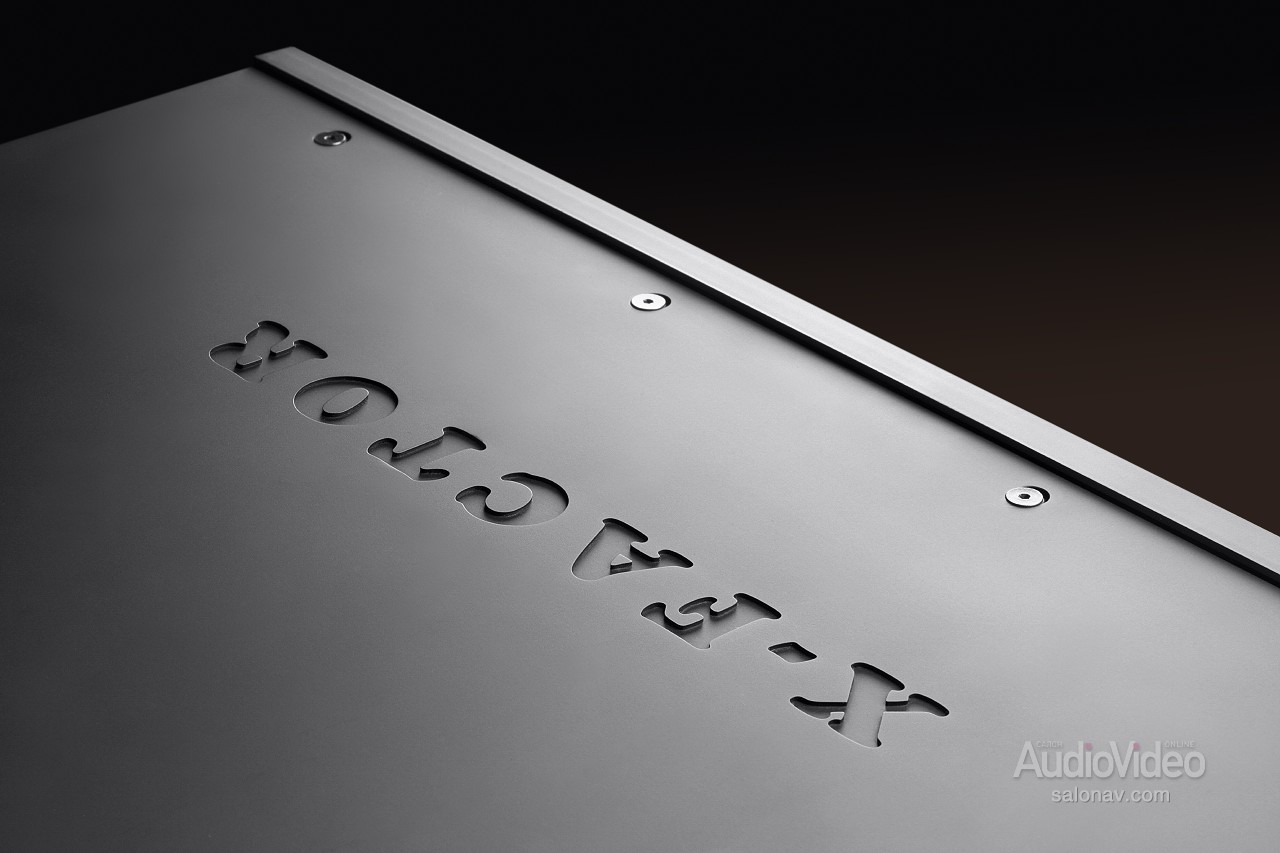
The DAC’s modules are assembled on multi-layer PCBs and have additional galvanic isolation from the XMOS board. Their power is supplied from a separate power transformer with its own power cord (!), while their circuitry is isolated from the common ground and is connected to the output buffer only.
X-Factor chassis consists of two sub-chassis: the inner one is made of steel, while the outer one is made of 14 mm-thick sheets of aluminum. The back plate of the chassis is made of a dielectric – it’s actually a very thick one-sided printed board. The reason for not using metals for the chassis’ back plate is to prevent eddy currents around the connectors installed there. The soft feet - filled with organic silicon inserts - under the outer chassis prevent external mechanical vibrations to penetrate inside of it.
After thoroughly testing this pre-production sample X-Factor’s team of engineers is planning to build a small production run of the units to fulfill the pre-orders for it. As availability for the original PCM1704 chips is very limited, since they were discontinued a long time ago, the production runs for the DAC must be very limited too.
If everything goes well, X-Factor is planning to manufacture an analog amplifier of the same absolute quality. Due to its no-holds-barred physical dimensions and weight, it will be assembled on the site. It’ll be a very heavy unit with a colossal power on the board: the total filter capacitance is planned in the amount of tens of Farads, while all the power supplies, including for the output stages, will be regulated.
X-Factor chassis consists of two sub-chassis: the inner one is made of steel, while the outer one is made of 14 mm-thick sheets of aluminum. The back plate of the chassis is made of a dielectric – it’s actually a very thick one-sided printed board. The reason for not using metals for the chassis’ back plate is to prevent eddy currents around the connectors installed there. The soft feet - filled with organic silicon inserts - under the outer chassis prevent external mechanical vibrations to penetrate inside of it.
After thoroughly testing this pre-production sample X-Factor’s team of engineers is planning to build a small production run of the units to fulfill the pre-orders for it. As availability for the original PCM1704 chips is very limited, since they were discontinued a long time ago, the production runs for the DAC must be very limited too.
If everything goes well, X-Factor is planning to manufacture an analog amplifier of the same absolute quality. Due to its no-holds-barred physical dimensions and weight, it will be assembled on the site. It’ll be a very heavy unit with a colossal power on the board: the total filter capacitance is planned in the amount of tens of Farads, while all the power supplies, including for the output stages, will be regulated.
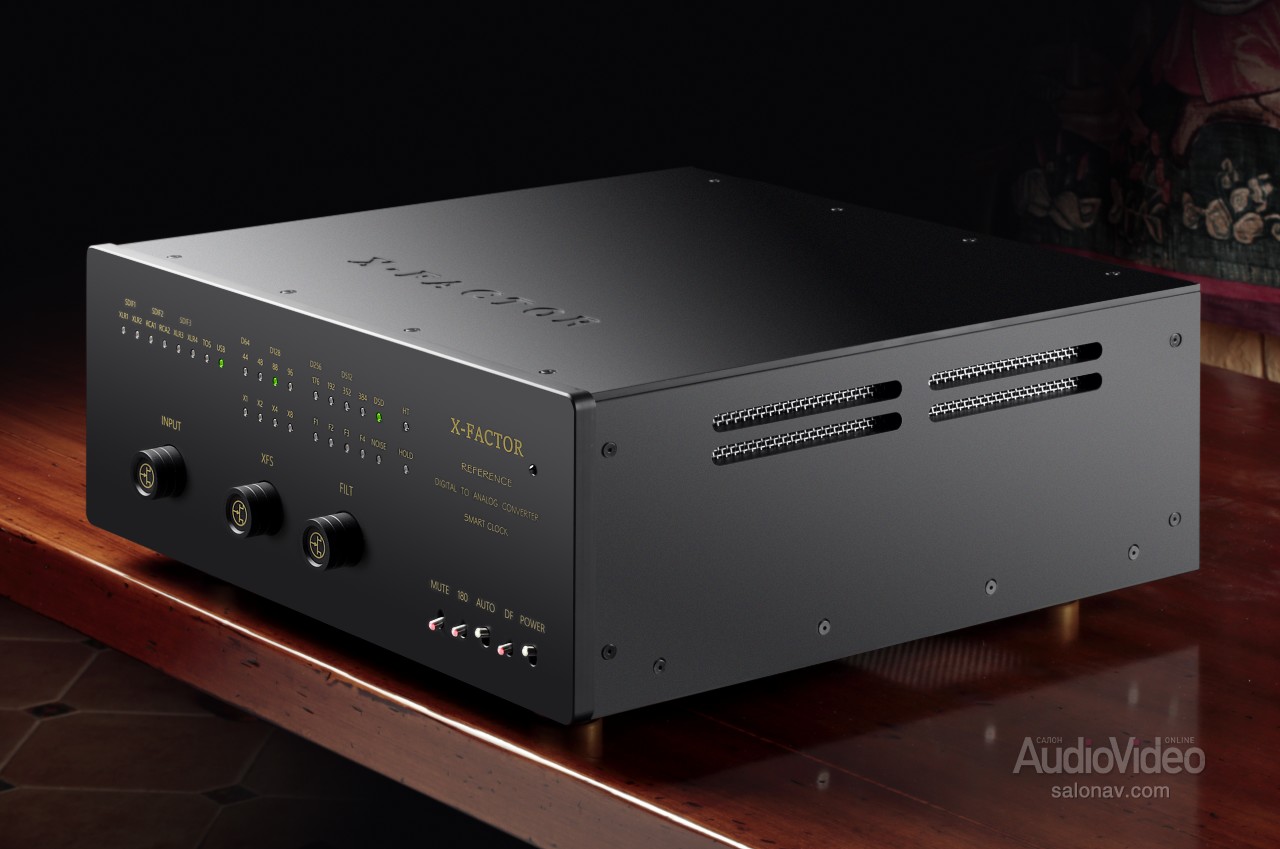
“Ruling Over The Roost”
Now, a few words about our reference system which was used to evaluate the DAC. We used Aurender W20SE music streamer, which recently was reviewed here and received our ultimate Grand Prix award as a result of it, as a source component. The line section of a well-known EMT JPA66 preamplifier we used for the tests was radically upgraded by the X-Factor team of engineers. The preamplifier’s output signal was fed to Theta Digital Citadel monoblock power amplifier. The humongous PBN Montana WAS loudspeakers with external crossovers were set up in a relatively small – for the loudspeakers – listening room, but we substantially mitigated the effects of such a mismatch with a help of Stein Music harmonizers. These smart boxes increase the subjectively perceived size of an acoustic space, that is, as it were, spreading the walls of it.
We started the listening tests by choosing the most obvious tracks from a local server, mostly, with the resolution of 24/192 and DSD128. Our first impressions were based not so much on the DAC’s own character, as on the loudspeakers’ behavior – these two meters tall monsters sounded as they were positioned in a big hall, in which you couldn’t hear nor any early reflections from its walls, nor any standing waves. During the most of the tracks’ playback time, the sound – with all of its density and amazing “color saturation” along the whole sonic spectrum - seemed to was just hanging in the air. Although, when such monsters, as Montana WAS, positioned in just a few meters from the listener, demonstrate such a disappearing act, it’s apparently a testament to the highest class of all the components in the audio system and especially of its source one. To form such a palpable three-dimensional soundstage, the phase (i.e., time) discrepancies between various reproduced frequencies should be minimal, and that was exactly what we have heard here. The sound radiation coherence was practically as perfect as we would had heard from some humongous full-range drivers, if such hypothetical drivers would had ever existed at all.
Now, a few words about our reference system which was used to evaluate the DAC. We used Aurender W20SE music streamer, which recently was reviewed here and received our ultimate Grand Prix award as a result of it, as a source component. The line section of a well-known EMT JPA66 preamplifier we used for the tests was radically upgraded by the X-Factor team of engineers. The preamplifier’s output signal was fed to Theta Digital Citadel monoblock power amplifier. The humongous PBN Montana WAS loudspeakers with external crossovers were set up in a relatively small – for the loudspeakers – listening room, but we substantially mitigated the effects of such a mismatch with a help of Stein Music harmonizers. These smart boxes increase the subjectively perceived size of an acoustic space, that is, as it were, spreading the walls of it.
We started the listening tests by choosing the most obvious tracks from a local server, mostly, with the resolution of 24/192 and DSD128. Our first impressions were based not so much on the DAC’s own character, as on the loudspeakers’ behavior – these two meters tall monsters sounded as they were positioned in a big hall, in which you couldn’t hear nor any early reflections from its walls, nor any standing waves. During the most of the tracks’ playback time, the sound – with all of its density and amazing “color saturation” along the whole sonic spectrum - seemed to was just hanging in the air. Although, when such monsters, as Montana WAS, positioned in just a few meters from the listener, demonstrate such a disappearing act, it’s apparently a testament to the highest class of all the components in the audio system and especially of its source one. To form such a palpable three-dimensional soundstage, the phase (i.e., time) discrepancies between various reproduced frequencies should be minimal, and that was exactly what we have heard here. The sound radiation coherence was practically as perfect as we would had heard from some humongous full-range drivers, if such hypothetical drivers would had ever existed at all.

The second feature that is impossible not to notice is the powerful energy component embedded in the sound. It has been mentioned several times that when playing files from a hard drive, the sound, while impeccable in terms of tonal accuracy, often lacks emotional depth, feeling somewhat "discharged." With X-Factor, this problem is completely absent - high-resolution files in terms of energy are unlikely to yield to CDs and, at the same time, boast colossal detail across the spectrum. Speaking of music, it leaves a stronger impression, captivating attention regardless of genre. It captivates due to the abundance of nuances, the play of microcontrasts, and all of this not on a flat plane, but in space. With DSD files, the atmosphere becomes more palpable, the sound becomes freer, subjectively increasing dynamics, especially in the upper range.
I must note that I have never noticed such a difference when switching digital filters before. Usually, it is felt through changes in the soundstage, almost on a subconscious level. Here, however, not only does the space change (becoming wider and deeper), but the tonal signature in the upper midrange and tweeter range is also perceived differently. Here, changes can be described in terms of "brighter - more resonant - calmer." This is especially noticeable on recordings with live, unsynthesized cymbals - with a wide-band filter, the characteristic timbre of metal is conveyed so authentically that it feels as if they are being struck right in the room.
I must note that I have never noticed such a difference when switching digital filters before. Usually, it is felt through changes in the soundstage, almost on a subconscious level. Here, however, not only does the space change (becoming wider and deeper), but the tonal signature in the upper midrange and tweeter range is also perceived differently. Here, changes can be described in terms of "brighter - more resonant - calmer." This is especially noticeable on recordings with live, unsynthesized cymbals - with a wide-band filter, the characteristic timbre of metal is conveyed so authentically that it feels as if they are being struck right in the room.
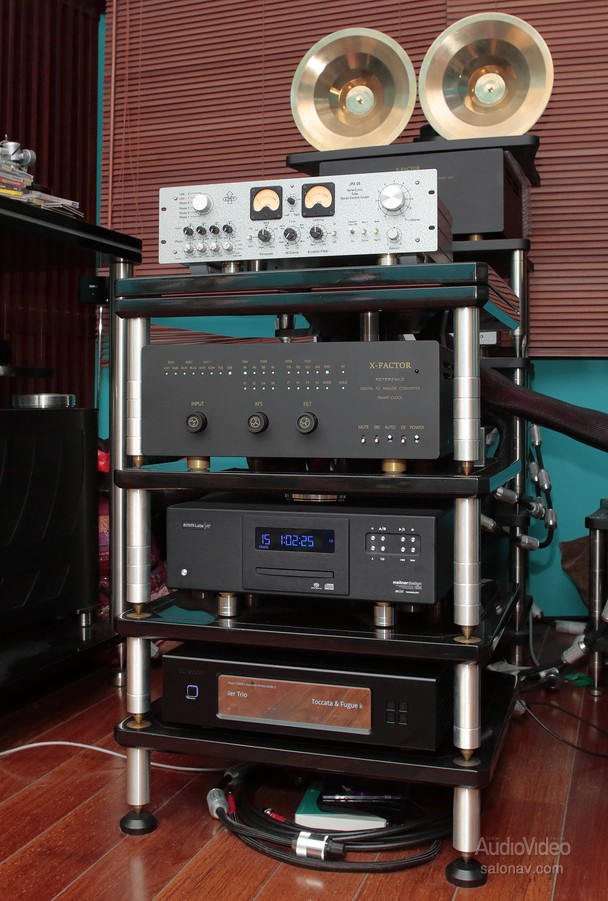
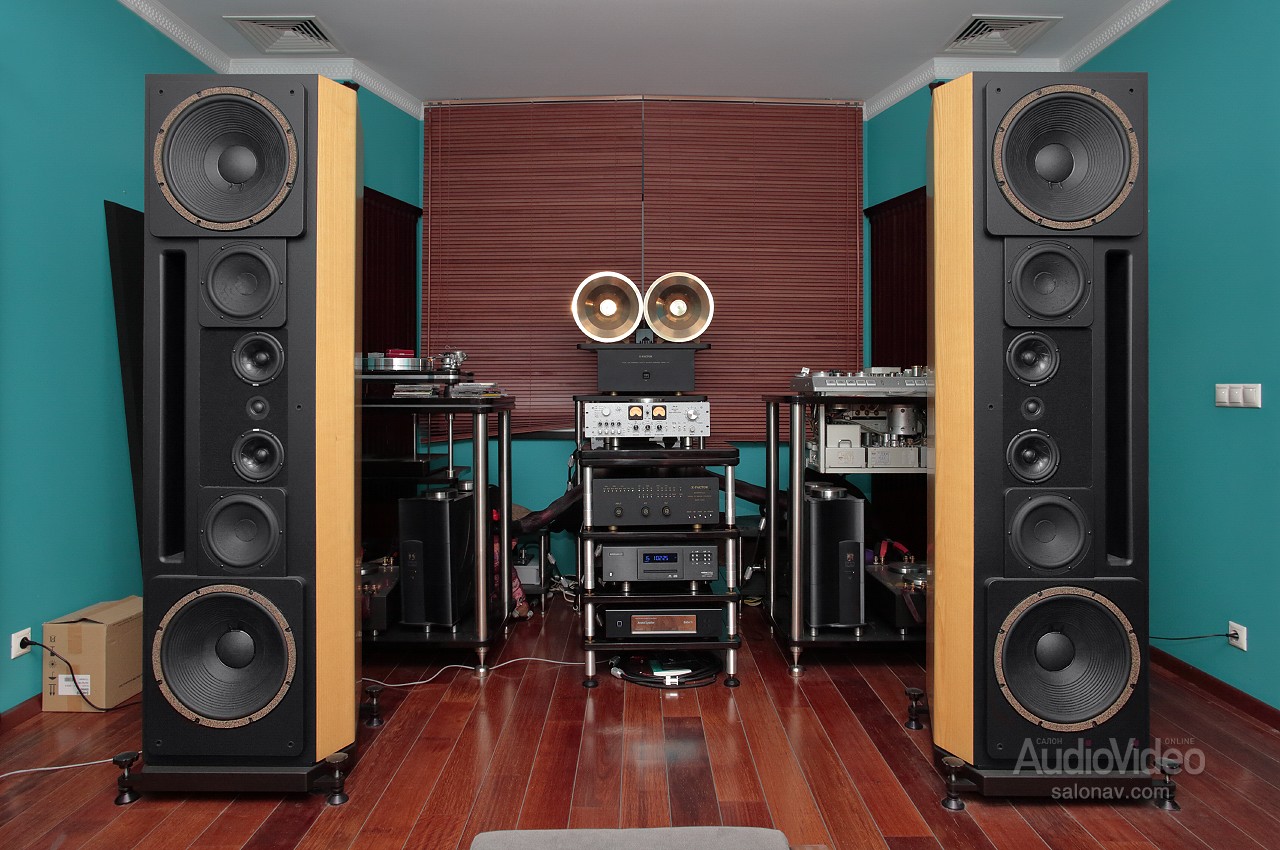
We also played some test CDs, using EMM Labs XDS1 player as a transport. The last time I heard PCM1704-based DACs was a long time ago, so I started to forget the specifics of their distinctive sound. In my opinion, from a technical standpoint, compared to all the other units using this chip I am aware of, the implementation of this technology in X-Factor DAC is the most sophisticated. On the one hand, a distinctive brutal punch, especially when reproducing the sound from CDs, which this technology is so associated with, is still here (while 44/16 rips from the same discs demonstrate quite noticeably subdued sound dynamic qualities – yes, I did a special test to prove this), but on the other, it’s not accompanied with a typical for much lesser device’s roughness. As a rule, it’s not difficult to identify high resolution recordings when they are compared with the CDs-quality ones, although in this case I would rather not hurry with the verdicts, as X-Factor DAC erases the clearly-cut sonic distinctions between the formats by removing the most typical artefacts of lesser resolution playback.
In particular – a slight roughness and a subtle chaotic disorder of the sound presentation. To me, it is a very important consideration, as while adjusting to listening to music via digital files only, I can still keep my CD collection – that is, even if the Compact Discs do lose in its overall sound quality to the high-rez format when reproduced by the reviewed DAC – although, not too significantly – at the same time, with some music genres, CDs can still provide a more satisfactory overall music experience than most of the current cutting-edge formats.
Our graphic designer, Vigen Amamchyan, joined me to audition the X-Factor DAC. Incidentally, our impressions during the listening test happened to be quite similar. “Unusually energetic and sonically robust presentation are the very aspects of the DAC’s sound that attract the attention from a get-go. Being fully aware that you’re dealing with an extraordinary product you immediately switch your casual auditioning mode over to a very concentrated and attentive one. Apparently, the DAC’s huge power supply unit with multiple power supply lines provides a substantial gain in its overall sound quality. The sound’s macro- and micro- dynamics’ presentation is excellent. Neither one nor the other dominates over the counterpart, all the sonic attributes are in perfect balance. Both micro resolution of fine nuances and thundering crescendos sound very convincing”.
In particular – a slight roughness and a subtle chaotic disorder of the sound presentation. To me, it is a very important consideration, as while adjusting to listening to music via digital files only, I can still keep my CD collection – that is, even if the Compact Discs do lose in its overall sound quality to the high-rez format when reproduced by the reviewed DAC – although, not too significantly – at the same time, with some music genres, CDs can still provide a more satisfactory overall music experience than most of the current cutting-edge formats.
Our graphic designer, Vigen Amamchyan, joined me to audition the X-Factor DAC. Incidentally, our impressions during the listening test happened to be quite similar. “Unusually energetic and sonically robust presentation are the very aspects of the DAC’s sound that attract the attention from a get-go. Being fully aware that you’re dealing with an extraordinary product you immediately switch your casual auditioning mode over to a very concentrated and attentive one. Apparently, the DAC’s huge power supply unit with multiple power supply lines provides a substantial gain in its overall sound quality. The sound’s macro- and micro- dynamics’ presentation is excellent. Neither one nor the other dominates over the counterpart, all the sonic attributes are in perfect balance. Both micro resolution of fine nuances and thundering crescendos sound very convincing”.
When comparing multi-bit conversion to delta-sigma, the difference is primarily felt in the transmission of attack. In the former case, the impact is perceived as less sharp, but it carries more textural richness and the vibrations that compose it. The same applies to music as a whole — there are many details, but they do not distract attention, and the overall sound seems more comfortable. In delta-sigma, imaginary images are conveyed more distinctly, the delivery is generally more impactful and contrasting. In particularly energetic genres, the sound may seem slightly "overdriven," but many prefer this specificity.
To test XMOS input module, we connected MacBook Pro with a collection of our test recordings’ library to it via the DAC’s USB input. Except for just a little bit of additional sonic fluidity and overall aural harmony which lead to a more relaxed overall music perception, when using the DAC in this configuration, I couldn’t really hear any substantial differences in the sound quality vs its audio streaming mode operation. You don’t feel a presence of any hardware operation between yourself and music, it seems as it flows by itself, coming out of nowhere. Actually, this is the main attribute of a classic audio system: that is, its sound presentation should be perceived as coming from an integral and harmonious entity which puts us in a state of total oblivion regarding various components’ separate inputs to it. Apparently, the central role to arrive at such a synergy of components is played by the source component – because if there is complete disorder in the head, nothing can be corrected downstream.
The System
The Source components:
The cables:
Technical Specifications:
Sourced from the Salon AV magazine, by Nikolay Efremov.
To test XMOS input module, we connected MacBook Pro with a collection of our test recordings’ library to it via the DAC’s USB input. Except for just a little bit of additional sonic fluidity and overall aural harmony which lead to a more relaxed overall music perception, when using the DAC in this configuration, I couldn’t really hear any substantial differences in the sound quality vs its audio streaming mode operation. You don’t feel a presence of any hardware operation between yourself and music, it seems as it flows by itself, coming out of nowhere. Actually, this is the main attribute of a classic audio system: that is, its sound presentation should be perceived as coming from an integral and harmonious entity which puts us in a state of total oblivion regarding various components’ separate inputs to it. Apparently, the central role to arrive at such a synergy of components is played by the source component – because if there is complete disorder in the head, nothing can be corrected downstream.
The System
The Source components:
- Aurender W20SE music streamer
- EMM Labs XDS1 CD-player (used as a transport)
- Apple Powerbook G4
- EMT JPA 66 preamplifier (upgraded)
- Theta Digital Citadel mono power amplifier
- PBN Montana WAS loudspeakers (with external crossovers)
- Pure Power AC power conditioner
The cables:
- all interconnect and loudspeaker cables are by X-Factor
- Fischer Performance-7 M1f1 power cables (upgraded)
Technical Specifications:
- Analog outputs: stereo RCA, stereo XLR.
- Digital inputs: 4 x XLR AES/EBU, 2 x SPDIF (Coax), 2 x USB 2.0.
- Supported bit-depths and sampling frequencies: XLR and Coax - up to 24 bit/192 kHz, USB – up to 32 bit/384 kHz, SDIF – up to 24 bit/384 kHz. DSD: DoP – 64/128/256, Native – 64/128/256/512.
- Signal-to-noise ratio: 119 dB
- Output voltage: 2.1 V RMS.
- Output impedance: RCA/XLR - < 10 Ohm.
- Bandwidth: 0 Hz is lowest frequency limit while the highest one is determined by the sampling frequency of the incoming digital signal.
- Dynamic range: no less than 147 dB (@ -60dBFS).
- AC Power supply voltages: 220/230/240 V, 50/60/400 Hz.
- Power consumption during full operation: no more than 100 W.
Sourced from the Salon AV magazine, by Nikolay Efremov.
